Tanks and Armored Vehicles of WW2
 This was their finest hour. Never in history have so many tanks and AFV's been built and fought all around the globe. From the snowy steppes of Russia to the soaky jungles of New Guinea, from the sands of Egypt to the grassy plains of Western Europe, the tanks were wherever soldiers were to be seen. They fought in most battles of the Second World War, some of these have become legendary like Kursk, one of the largest armoured clashes in the history of mankind. Some new tactics were developed during the interwar and refined, such as the "Blitzkrieg" which proved decisive and changed the way tanks would be used thereafter.
This was their finest hour. Never in history have so many tanks and AFV's been built and fought all around the globe. From the snowy steppes of Russia to the soaky jungles of New Guinea, from the sands of Egypt to the grassy plains of Western Europe, the tanks were wherever soldiers were to be seen. They fought in most battles of the Second World War, some of these have become legendary like Kursk, one of the largest armoured clashes in the history of mankind. Some new tactics were developed during the interwar and refined, such as the "Blitzkrieg" which proved decisive and changed the way tanks would be used thereafter.
The Second World War
 Argentina
Argentina
 Belgium
Belgium Canada
Canada
 China
China Czechoslovakia
Czechoslovakia Finland
Finland France
France Hungary
Hungary India
India Italy
Italy Japan
Japan Nazi Germany
Nazi Germany New Zealand
New Zealand Poland
Poland Romania
Romania South Africa
South Africa Soviet Union
Soviet Union Spain
Spain Sweden
Sweden The Netherlands
The Netherlands United Kingdom
United Kingdom USA
USA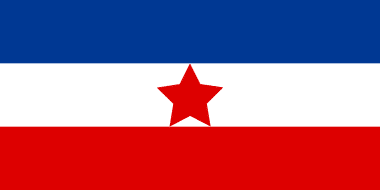 Yugoslavia
YugoslaviaPart I: Interwar tactics
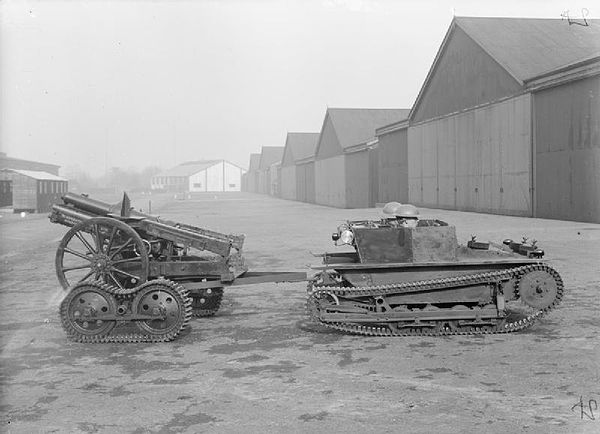

The Vickers Carden-Lloyd tankette seemed a cheap and efficient way to mass-produce armoured vehicles, and to experiment with fully motorized units on a tactical and operational level. Credits - Wikimedia commons - A Carden-Loyd Mk.VI tankette. First produced in 1928 and largely exported and built under licence throughout the world, it was one of the most serious attempts to built a truly mechanized army. Fast, lightweight and agile, it was designed to carry a single Bren machine-gun, two personnel and some material and could sustain only infantry fire
During WWI the tank was first used with mixed success, but its deployment was aimed at cleaning up enemy lines with more precision than a massive artillery barrage. Tanks were also followed closely by infantry, staying with them during the breakthrough, mostly to deal with machine-gun nests. This tactic was developed and refined at a steady pace by both the British and the French, and three classes of tanks were defined. Infantry tanks were well-armed and well protected but utterly slow (infantry pace). Cavalry tanks were, on the contrary, very fast and agile, but lightly protected and with weak armament.
They were used for scouting operations and advancing deep behind enemy lines. Lastly, a heavy tank model was developed, the French "char de rupture" or "breakthrough tank", which was heavily protected and armed, built to deal with other tanks as well as destroying well-protected enemy positions and bunkers. All these tanks types were spread among infantry formations, attached to them as well as supporting artillery units. No really independent mechanized corps concept was defined, at least until the beginning of WWII. In 1939, this was the main tactical vision favored by the Allies.
Not everybody was satisfied with this "support role" for the tanks. Some British theoreticians and officers like Liddel Hart and J.F.C. Fuller were attached to the first tank units during the First World War, and quickly grasped all their potential. Liddel Hart also wrote about a secondary campaign, the Palestinian one against the Ottoman Empire led by General Allenby, who favored a successful "indirect approach". Both were published and acquired some fame among German officers, including Manstein and Guderian. The idea of "mechanized warfare", and fast tanks, also originated in Britain. The Christie tank suspensions were revolutionary, and fast armored columns were put to the test prior to 1935, with Bren Carriers and light Carden-Lloyd tankettes.
Part II: Blitzkrieg
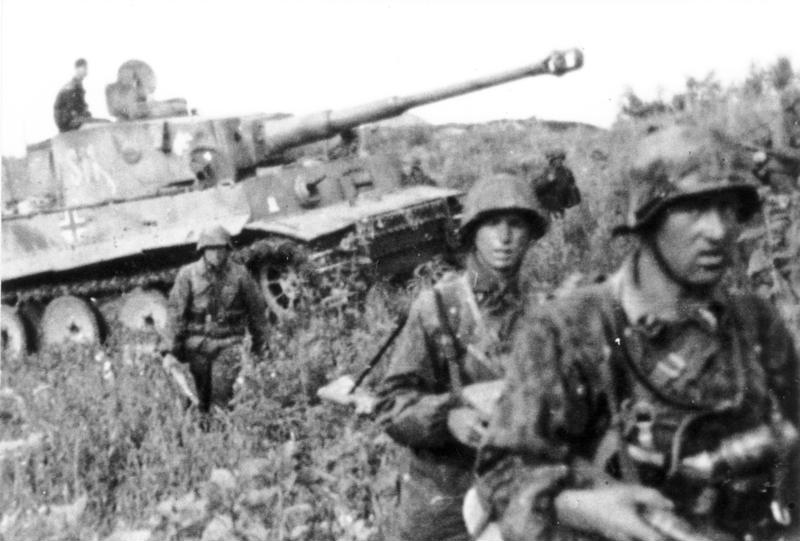
One of the last Blitzkrieg-style German offensives on the Eastern Front. Kursk, summer 1943. One of the last Blitzkrieg-style German offensives on the Eastern Front. Kursk, summer 1943.
This famous German word literally means "lightning war". However this was not describing a tank tactic, but rather a whole combined arms strategy, and was put in practice with a master principle: "Strike by surprise, strike fast and strike hard". This was also a means seen by some third Reich geopoliticians to win quick and "cheap" wars without having to enter a long, proactive war of attrition that Germany could not afford at this time. This strategy involved several steps:
- Strike by surprise: The Blitzkrieg is triggered before the breaking of diplomatic relationships.
- Strike by surprise: The Blitzkrieg is triggered before the breaking of diplomatic relationships.
- Military airfields are the first to be attacked; most of the enemy air forces have to be destroyed before even taking off.
- Military airfields are the first to be attacked; most of the enemy air forces have to be destroyed before even taking off.
- Strike fast: Paratroopers or glider-airborne commandos seize by night all the bridges, com centers and other valuable targets.
- Strike fast: Paratroopers or glider-airborne commandos seize by night all the bridges, com centers and other valuable targets.
- A "fifth column" disguised as regular soldiers of the enemy forces creates confusion and havoc behind enemy lines
- A "fifth column" disguised as regular soldiers of the enemy forces creates confusion and havoc behind enemy lines
- Strike hard: At noon, the ground assault begins. A spearhead of tanks followed by mechanized infantry, closely supported by the air force.
- Strike hard: At noon, the ground assault begins. A spearhead of tanks followed by mechanized infantry, closely supported by the air force.
- The mechanized spearhead makes a breakthrough and deep penetration in enemy lines. The main forces, still intact, are outflanked, outmaneuvered and surrounded.
- The mechanized spearhead makes a breakthrough and deep penetration in enemy lines. The main forces, still intact, are outflanked, outmaneuvered and surrounded.
- Following this mechanized fast assault, regular troops arrive with artillery, to deal with the last resistance pockets.
- Following this mechanized fast assault, regular troops arrive with artillery, to deal with the last resistance pockets.
This kind of offensive however, proved so successful that, in time, a myth emerged of German invincibility, which was not to prove true in the long run. Although both Allied camps -west and east- had to push forward an immense industrial capacity and large numbers of men to win, the Allies also learned to use almost similar tactics to forge their own successes. US General Patton for example, showed probably the best Allied version of it, being instrumental in the rapid breakthrough from Normandy to the Rhine. From then on, the "Blitzkrieg" maintained this fast-moving, combined-arms flavor. The terms were still the preferred ones by the general media when relating the allied offensive to liberate Kuwait from the Iraqis in 1990.
Part III: Soviet military doctrine

From its early beginnings from the ashes of Civil War, the Red Army viewed prospects of military strategy and tactics with a fresh eye. The old Tsarist military traditions were all gone along with the officers, nearly all "whites", killed, deported to Siberia, or exiled. But if the Boshelviks had men and some worn-out tanks and armored cars, they were also deeply aware of the past failures and defeats of the Russian military (plus their own experience against Poland in 1919-20), and consequently sought to embrace new ideas.
The early opposition between Leon Trotsky and Mikhail Frunze, an experienced commander, turned into profit for the latter, fueling a comprehensive debate from which emerged several concepts appropriate to the needs of the Red Army and its defense policy for the years to come. During these exchanges, for example, Tukhachevsky defended the idea of a decisive battle while Alexander Svechin professed that the Russian territory was ideally suited for a war of attrition.
However, if the USSR was still weak and not yet industrially prepared to face a long attrition war, when Stalin came to power and enforced a giant, ruthless industrial effort, these views began to change and Marshal Tukhachevsky's first ideas gained favor. An attack-based policy gained full support at all levels of the military. The Deep Battle Concept was adopted in 1933 - a set of operational rules mixing Svechin aspects to conduct the strategy and Tukhachevsky’s, (aided by Vladimir Triandafillov) vision at the tactical and operational levels. The Russians were also the first to theorize in this area a third "operational art" between the tactical and strategic levels. "Provisional Instructions for Organizing the Deep Battle" became the official manual of the Red Army and remained in use until 1941 -by then with disastrous consequences.
The Deep Battle Concept, in short, professed a simultaneous combined-armed and combined-units strategy to gain victory on a specific part of the front, thus allowing a decisive breakthrough in order to render the enemy's defense of the entire front useless, or impossible. Several units were used as a bait, to attract and divert the attention, while the main effort was aimed at a specific point. These diversionary operations both prevented the enemy from moving reserves where the main breakthrough was taking place, and any effort to organize an elastic defense. The general headquarters was the Stavka, which directed a front, split into several "armies", fully autonomous units with all their components (infantry, air, tanks, artillery) also split into divisions, some of which were motorized, known as the shock divisions.
The Deep Battle concept could however be adapted also for a defensive operation. One important aspect, professed by Georgii Isserson, was the depth of operations - thus giving its name to the whole concept - proper to the Russian soil. He calculated attack echelons of 100-120 km. The breakthrough mobilized rapid-moving mechanized divisions and airborne divisions, establishing a deep but narrow secured perimeter over 40-80 km in enemy territory to be exploited. This alone, dictated the types of tanks used by the Red Army in the thirties.
The T-28 and T-35 were essentially breakthrough tanks, the BT cruisers were used for the rapid exploitation of the breakthrough penetrating deeply in the enemy's rear, and the T-26s were to carry the main attack and fully secure the area.
The "Glubokaya operatsiya" or "deep operations" concept was theorized in detail by Triandafilov and his successor, Nikolai Efimovich Varfolomeev. Both professed a range of simultaneous blows throughout the entire depth of the enemy operational defense. By 1936, these generated field army regulations, but the massive officer purges left only loyal officers, not always experienced, with this rigid set of rules and without a full understanding of local flexibility inside this framework. Under the firm grasp of political commissars, and with the fear of taking initiatives, many officers were left alone inside a rigid chain of command taking orders right from Moscow. All these facts contributed in 1941 to a spectacular defeat for the biggest army on Earth at the time, although applying with zeal the concept for a defense and attack in depth which was one of the most advanced for the time.
Part IV: Central Europe & Spain
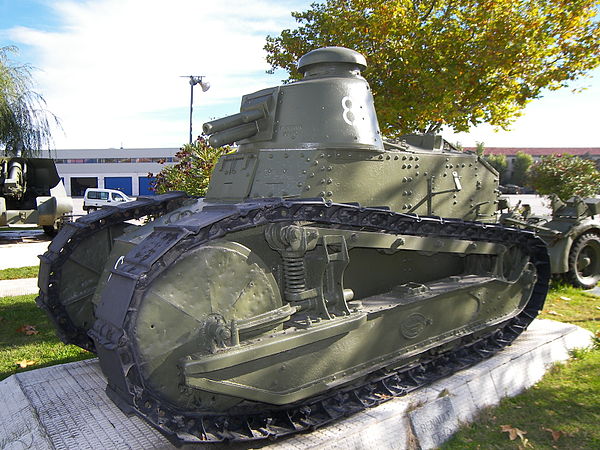
A Spanish Republican FT - Credits wikimedia commons, author JonCatalán, shot at El Goloso Museum of Armored Vehicles
The years 1935-38 were not quiet in the world, nor in Europe itself. By 1935, Italy was launching the conquest of eastern Africa, while Japan was attacking Manchuria and, later, the whole of China starting from Nanking. In central Europe, the new map drawn postwar suited almost none of the central European powers of the time. Germany, for example, was cut in two with the "Danzig Corridor" like a scar on its eastern edge. Southwards, the Czechs threatened to seize bordering territories in dispute since 1922. Czechoslovakia itself was harassed from within by Germanophile extremists supported by the Third Reich. In Hungary and Romania, the situation was not clear, and for long, the USSR had some interest in the rich north-eastern Bessarabian oilfields. Hungary, another country born from the remnants of the Austro-Hungarian Empire, was also in a state of quasi-war with Czechoslovakia, due to border disputes.
Last but not least, starting in 1933, Germany entered the fray of central European border disputes. By 1935, Hitler was gambling on a new way to acquire lands. Call the "Germanic minorities" from any neighboring country to join the Third Reich. Three million German Bohemians, 23% of the total population of Czechoslovakia, dwelled in the Sudetenland, a rich and industrially dynamic region. The local Nazi party or Sudeten German Party won a majority in 1935 and campaigned for the attachment to the "great Reich" with the full support of Nazi Germany. After May 1938, the Czech army mobilized while the Germans moved their chess pieces. First, troubles fomented by the Sudetendeutsche Freikorps, then a full "insurrection" supported by the Wehrmacht, and finally, in September, the full annexation of the Bohemia-Moravia region to Germany.
The Allies did nothing. With it came most of the industrial resources and capacity of the Czech Republic. The Czech tank industry and arms manufacturers were renowned worldwide. Exports all around the world were a trademark of companies like Praga-CKD, and alongside the resources brought to the Reich came new tanks, notably the excellent Panzer 38(t), later refined into the tank-hunter Hetzer.
In Spain, the troubles came with the elections of 1936, which brought to power a clear majority of socialists, with some communists and anarchists in the government. The entire Spanish conservative society, the bourgeoisie, the landowners, factory owners, and in general the old institutions like the Church and part of the Army felt threatened and later took up arms. Nationalist troops under Franco crossed the Strait of Gibraltar and began their own "reconquista" from the south of Spain. Later on, sympathetic regimes to the Nationalists like fascist Italy and Nazi Germany poured in reinforcements and sent expeditionary forces.
After a series of defeats, the Republicans, at first not supported by supposedly friendly regimes (France and Great Britain which remained quiet by fear of internal disorders and even a full scale European war), received however some weaponry, and most importantly, spontaneous help from the "Brigadas Internacionales". But only when the USSR decided to side with the Republicans, did massive material reinforcements began to arrive (tanks, artillery and planes). Spain became not only, from 1936 to 1939, the battleground of two clear political factions, visions and ideologies, but also a proving ground for the latest military assets of the concerned nations.
Tank designs of the thirties were challenged, and new tactics devised, which were lessons for Word War Two. Apart from the hundreds of armored cars used during the conflict, the Republicans fielded old French FTs, brand-new Russian T-26s and BT-7s, and the Nationalists, German Panzer Is and Italian CV-33/35 tankettes.
Part V: Poland and Finland
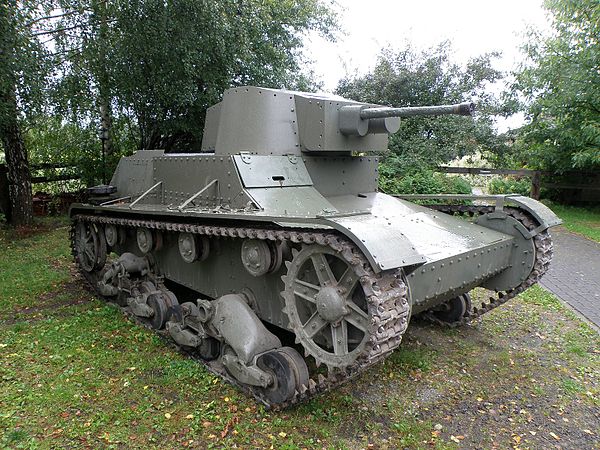

Reconstructed 7TP in 2011, credits Huippo - Wikimedia commons. This was the best Polish tank at the time, but only a few were available.
September 1939: The war started soon after Germany signed -to the world's later astonishment- a non-aggression pact with its supposedly mortal enemy, the USSR. Part of the agreement included sharing of the future dismembered Poland, unfortunately, placed between two powerful, traditional enemies. Germany wanted its own pre-WWI territories back and put an end of the fiction of the "Danzig Corridor", and the USSR wanted to avenge its defeat of 1919 and settle centuries-old disputes over eastern Poland. At the same time, Hitler had gambled that France and Great Britain, nominally allied to Poland, would remain inactive, as had happened with the "Lesson of Munich".
That was not the case however. For both practical and political reasons both nations were unable to immediately launch any sort of attack to attempt to relieve the pressure in Poland. Both had to mobilize and build up forces before any operations could commence. Both nations considered themselves not ready yet for a big offensive against major powers, and Poland seemed an easy prey. The German Panzer divisions only fielded a few of the new Panzer IIIs and even less Panzer IVs, committed for support. The bulk of their force was made of light Panzer I/IIs, which were only marginally better than armored cars, and a few Czech-built Panzer 38(t)s.
However, they counted on the faultless support of the Luftwaffe and good training, against a force consisting mainly of conscripts and a small but well-trained and well-equipped professional standing army. Along with its numerical inferiority in tanks and even more so in planes, Poland only counted a few relatively modern and efficient tanks, the 7TPs. Only a hundred were available, while the others were predominantly TK/TK3 tankettes. The German offensive was a success, but it also highlighted many deficiencies in communications and tactical, technical and logistical issues, as the losses were much higher than expected in the OKH. When the end was near, the Soviet forces attacked from the east, facing little opposition.
The "Winter War", also called the Finnish Campaign, was the first serious test for the Soviet armored forces. The battleground was quite different than the hot and dry valleys of Spain. It began in November 1939, both for tactical and practical reasons. The marshy ground of eastern Finland, which was also littered with lakes favored the defensive and virtually annihilated any attempt to make a large-scale armored assault. With only frozen surfaces in winter, the flat terrain then became suitable for fast motorized columns.
Just like in Poland, this was a David against Goliath type of encounter, the Soviets fielding an advantage of 3:1 in men, 30:1 in airplanes and even 100:1 in tanks. It was seen by the Stavka like a military picnic. But against all expectations, the Finns put up a brilliant resistance, using the weather and everything they could muster to hold back and defeat entire units, wiping out tens of thousands of men, and capturing hundreds of vehicles in the process. But with few reinforcements and little support from their allies, partly due to the firm neutrality of neighboring Sweden, and with massive Soviet reinforcements, the Finns eventually lost their eastern territories located around the Lake Ladoga, to be ceded by the Treaty of Moscow in March 1940.
The Russians losses were partly due to a combination of internal deficiencies, the main one being the lack of experienced officers (30,000 had been recently killed or deported during Stalin's great purges). Many old tank models showed their limitations, but several prototypes were also tested in real conditions, including the SMK, the KV-1 and KV-2, as well as the BT-7M, an ancestor of the T-34. The Finns had virtually no tanks at the beginning of the conflict, ending with four times more, uniquely due to captures, many of which were later converted or enhanced. The Winter War triggered a reaction by the Wehrmacht which resulted in the ensuing Norwegian campaign, where tanks would be virtually absent.
Part VI: The Western campaign
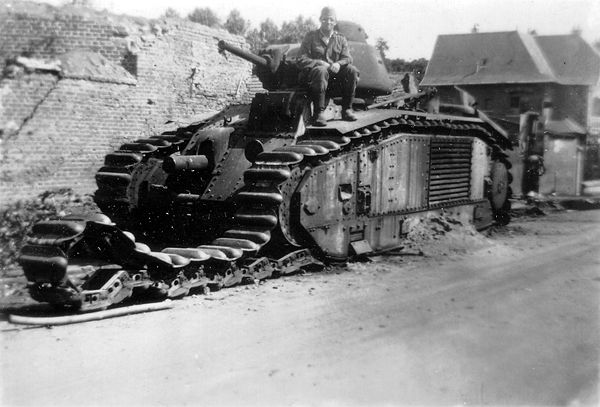
Disabled Char B1 bis, credits wikimedia commons - Conseil Régional de Basse-Normandie/National Archives USA (col. Normandie Mémoire) Disabled Char B1 bis, credits wikimedia commons - Conseil Régional de Basse-Normandie/National Archives USA (col. Normandie Mémoire)
Norway, 1940
Most operations in this theater were performed by paratroopers and infantry alone, with limited artillery support and virtually no tanks. The reasons were obvious, dictated by the rough terrain in the areas of major interest, more suitable for lightly equipped mountain troops. Nevertheless, Germany landed a single unit comprising Panzer Is to support infantry against the committed Norwegians. The latter lacked any form of armored vehicles save for a few armored cars used for police purposes and had a limited number of antitank guns.
Alongside the Panzer Is, Germany also committed three of its new heavy tanks, with limited purposes other than propaganda. These stayed in Norway until the end of the war, stationed near the Oslo Fortress. Despite taking heavy losses at sea, the German forces held their ground and Allied efforts to recapture major objectives failed against a resolute defense. By May, the concentration of forces in the west rendered all upcoming operations useless and the Allies evacuated.
Opposing forces
One of the most thrilling issues of WWII, still debated among historians, is how the Allies - who on paper largely outnumbered the Germans - could have taken such a blow in a few days.
The Germans held French tanks in high esteem, especially the heavy B1 bis. Except for the still large numbers of WWI era FTs and the gargantuan FCM 2Cs, most French tanks were built in the mid and late thirties, assembled by welding with cast parts and featured excellent protection. But they were slow (infantry pace), according to the tactics of the time, used short-barrel guns to deal with fortifications and machine-gun nests, and had small turrets which forced the tank commander to multi-task. This was aggravated by the lack of intercom or radio.
The chain of command was utterly rigid; movements were carefully planned with a combination of artillery and infantry, with tanks in support. Tank commanders were not supposed to take initiative on the field. The British forces also fielded excellent tanks, the best being the Matilda II, with a frontal armor superior to anything the Germans could offer. The professional and well-trained BEF was also well equipped with Cruiser I, II and IIIs for breakthroughs and Light Mk. IV, V, and VIs for reconnaissance, plus numerous armored cars. However, British tanks were constructed with rivets, had two-man turrets and also lacked radio or intercom. The chain of command was equally rigid, as late-WWI tactics dominated the minds of both General Staffs.
The Belgian army was built to stand its ground for some time, but relied on neutrality and several fortifications like the formidable Eben-Emael fort which controlled crucial crossroads and was deemed impregnable. The Belgian army fielded around two hundred 47 mm (1.85 in) AT guns, and around four hundred light tanks, some designed for infantry support and only armed with a heavy machine gun and others with light AT guns. Most of their successes were attributed to well-placed ambushing units. The worst came when German paratroopers faultlessly seized Eben-Emael. This was a serious blow to Allied plans, which conducted a rush of the 1st French Army into Belgium, long before the expected schedule. The Netherlands also saw heavy fighting for several days, until Rotterdam was bombed and they subsequently surrendered. Their army was poorly equipped, and only counted a handful of armored cars, some recent and some obsolete. The bulk of its armored forces was stationed abroad, in the Dutch East Indies.
In stark contrast, the Germans fielded fewer tanks, and their philosophy of use was quite different. Heinz Guderian and Erich Von Manstein were both keen to try the new armored warfare tactics, experimented with for some time in Great Britain. The real novelty was the use of large, autonomous armored formations (the Panzer divisions). The tactics called for the use of synchronized air support. Armored formations were set to produce decisive breakthroughs at specific locations along the enemy lines (the "Schwerpunkt"), and then either converging to the rear of the enemy to create large pockets, to be left afterwards to the artillery, infantry and aviation.
The German tanks were designed to fulfill such tactics. They were generally fast, with reasonably good armor and weaponry. They also used modern building and assembly techniques (welding) and, at least on the main battle tank, the Panzer III, and the support Panzer IV, roomy three-man turrets with intercom and radios for individual tanks. This allowed the tank commander to have a great deal of autonomy and, at the same time, versatility and coordination with others in real time.
Given the protection of the time, the Panzer I was of limited value, but kept for scouting operations. The light Panzer II was equally kept for the same task, and the Czech-built Panzer 38(t) served as a battle-line tank, for screening and flanking. Even the main battle tank, the Panzer III, was certainly not invincible.
The frontal armor was 30-40 mm (1.18-1.57 in) thick at best for the early series, and 45-50 mm (1.77-1.97 in) for the hundred Ausf. Fs fielded in May 1940. Most were still equipped with a puny 37 mm (1.46 in) gun derived from the standard Waffenamt 3.7 cm Pak 36, of limited value against most of the French tanks. These guns were called by the Allies and Germans alike "door knockers". However, a few of the new Ausf. Fs, up-gunned with a 50 mm (1.97 in) gun, could deal with most Allied tanks with efficiency. The few Panzer IVs were support tanks, equipped with a short-barrel 75 mm (2.95 in) howitzer and not intended to deal with other tanks.
Despite these limitations, the Germans prevailed due to a combination of several factors combined.
-Tactics. German tanks were used in a concentrated manner, while Allied tanks were dispersed to support the infantry. Despite their numbers, Allied units were destroyed piecemeal because of their local inferiority in numbers.
-Coordination. When dealing with superior tanks (like the B1), the Germans used coordination and cooperation, well-exercised in training, along with real-time communication. They overwhelmed tanks individually, and then dealt with another, akin to a pack of wolves. By contrast, French tank commanders were having difficulties loading, aiming, firing and scanning the battlefield at the same time.
-Air support. The BEF provided limited air support and the French air force had been already largely destroyed on the ground by the Luftwaffe. As a result of a rigid use of the air force, scattered in numerous units, each dependent on specific areas related to the army group, and the lack of coordination, the Allied high command was unable to use aviation support properly, while the Luftwaffe (especially the Stukas) were available to any unit and could be alerted by radio by a tank commander for immediate support at any location. The Luftwaffe decimated entire tank units on the move to intercept the main advance.
-The chain of command was similarly organized on both sides and the Allied side had a unified supreme command. However, on the Allied side, the aspects of local command and tactical independence at any level clearly marked the dominance of rigid WWI era tactics. Many French units were without orders for days, lacking the most elementary form of communication with all the echelons, and were virtually paralyzed. Intelligence crucially lacked from the lower echelons to the heads of staff. There was but a single telephone on Gamelin's desk.
-Psychological warfare. The French command was quite confident, even overly-optimistic about their capacity to deal with the Germans. When the situation changed dramatically for the worst, their plans were shattered, followed by confused orders and counter-orders. The sheer speed of the German advance surprised the hierarchy and threw the heads of staff into disarray. All the superior officers, with few exceptions, were mentally stuck in an infantry-pace style of warfare - set-piece battles carefully planned. Many officers also showed poor management of the situation, reacting "by the book" with obsolete tactics which further aggravated the situation.
Lacking training, equipment and orders, and left with loose discipline, French soldiers were found facing a highly motivated, well-trained, younger and well-equipped autonomous German infantry. With the full use of air support (especially the terrifying Stukas), ensuring French ground forces were unable to resist for long, or -in most cases- unable to fight at all, and the French were surrounded and taken prisoner en masse. The fleeing civilians (from Belgium and Northern France) hampered and blocked the roads, and thus the movements of troops, reinforcements and supplies, and left entire units deprived of fuel, orders or both.
Part VII: The African campaign (1940-43)
The involvement of the German forces, victorious over the Western powers in September 1940, came almost as an accident. Benito Mussolini, the Italian dictator, long wanted to dominate the Mediterranean ("Mare Nostrum") and the Suez Canal was an especially juicy prize, and a considerable asset for the Axis war effort. It was seen as one of the two jugulars of the British Empire, the other being the sea routes to the American continent. But the Regio Esercito (Royal Army) was still under the control of the King, Victor-Emmanuel III, de facto commander-in-chief. Initially, knowing that Italy was not ready for war, he and his staff rejected Mussolini's ambitions over the Mediterranean, although the quick defeat of France made for a complete reversal of opinions. Mussolini himself did not anticipate a long, protracted war with Great Britain, which seemed, at the time, in a position to only negotiate.However, with one armored and two motorized infantry divisions in Libya and Eritrea, the close support of "Supermarina" (The powerful Italian fleet), and the support of bombers based in Sicily and Calabria –(not counting those in North Africa), Marshal Grazziani was, on paper, able to unleash a devastating all-out offensive against the British interests in this area. France was now tamed and, at least in theory, neutral, but with hostile tendencies towards British Forces after the events of Mers-El-Kebir in August. But the head of staff decided to strike at another theater of operation, with the conquest of British Somaliland. It lasted between 7 and 19 August 1940 and ended as a decisive victory for the Italian army, and a six month occupation of these territories. The operation saw mostly armored cars on both sides, plus some CV-33 tankettes on the Italian side.
However, the British struck back in December 1940, during Operation Compass. It ended in February 1941 with a stunning victory over Italian forces, ending with the conquest of all of Cyrenaica and the capture of a large amount of prisoners and material. The British models seen in action there were Matilda IIs, Valentines (first version), and the Cruisers III and IV, along with several AC types.
Part VIII: Operation Barbarossa (1941-42)
The most formidable invasion on the axis side was a logical consequence of the aborted invasion of UK (Operation Seelöwe) in the previous summer of 1940 following the inability of the Luftwaffe to eliminate the RAF. Behind there were more long-terms concerns, personal beliefs of Hitler, an ideological desire to conquer and repopulate the USSR by Germans, and to use Slavs as a slave labour force, as well as getting hands on a formidable reserve of natural resources, including vital oil. It was to be the pinnacle of the combined Wehrmacht/Luftwaffe abilities, unleashed against, at least numerically, the largest force on Earth, over the largest possible landmass. German Tanks of course, as part of the Armoured Divisions or Panzerdivisions, would be at the forefront of a new blitzkrieg, with the same staggering speed but much more might compared to one year earlier. Meanwhile indeed, German Industries did not stayed idle. There were this time much more Panzer-IIIs than any other model n service, closely followed by Panzer IVs, Czech Panzer 38(t) and the first STUG-IIIs.The scale of the assault was unsurpassed in history, it was compared to 1812 Napoleon's Russian campaign, but the latter Grande Armee "only" numbered 680,000 soldiers, whereas in total no less than four million Axis personnel invaded the western Soviet Union, along a 2,900-kilometer (1,800 mi) front. Outside Panzerdivisions, the bulk was made of Infantry Divisions, only partially motorized, progresses in that matter has been made however, and 600,000 motor vehicles and between 600,000 and 700,000 horses were to be deployed. Many trucks were captured models, mostly from France. The goal was of course Moskow, but Hitler soon intended to take Ukrainian oil-rich reserves.
Part IX: The Mediterranean front (1943-45)
Work in progress...
Part X: The turning point (1942-44)
Work in progress...
Part XI: The Pacific campaign

Chi-Ha Shinhoto in Burma (cdts wio.ru)
What is called the "Pacific Campaign" was, in reality, a composite of several campaigns in the whole Asian theater of operations, spanning a far larger area than the Western and African campaigns. This started with the Chinese campaign, which begun in 1937 with the assault on Shanghai, and was later incorporated into the framework of WW2. Also associated is the early Japanese series of invasions (December 1941) and the "island hopping campaign", which started with the assault of Guadalcanal and the Solomons by the 1st Marine Division in the fall of 1942. While on islands tanks did played little role, they fared little better in dense jungles common to most areas that saw the bulk of the fighting from infantry, from Guadalcanal through New Guinea, the Philippines or Java. Situation was different however in Indochina, Burma and naturally China. Let's not forget that the first tank engagements began between Soviet and Japanese over the disputed China/Mongolia frontier at Khalking Gol (or Nomonhan) in a serie of clashes between May and September 1939.
This kick-started the slow and painful reconquest of the Southern Pacific, followed by the Central and Western Pacific islands. Why a single chapter for this instead of several ones? Because the main actor of the event, the IJA or Imperial Japanese Army, did not possess large fleets of tanks, and the ones that existed were not used in independent units, as the Germans did with their Panzer divisions. Moreover, the terrain where these forces were engaged did not favor tanks at all, featuring deep, impassable, and rain-soaked jungles and small coral islands, in which the Japanese armored forces were widely dispersed, and tanks were used mostly for infantry support.
IJN operations in China
During the early part of the operations, Type 97 medium tanks, Type 95 light tanks and Type 97 tankettes were available, but used for infantry support all along the Manchurian conquest. In the latter phase (1937 onward), most of the armored units were transferred to the operations in Nanking (Shanghai). The Manchurian state was consolidated under the rule of a puppet government, and most of the armor used there consisted of armored cars of various types. During the second phase of the Chinese campaign, aimed at Peking and the biggest industrial centers, tanks were still used for infantry support, while the conquered territories were patrolled by armored cars. The latter formed the backbone of the occupation forces, while more and more armored units were stationed on the borders.In 1939, the Sino-Mongolian-Soviet series of border clashes saw the Russians and Japanese engaged in several actions on the Khalkhin Gol/Nomonhan plateau and around key road and railway junctions. During the latter phase, massive Russian forces, along with armored units, were engaged in the takeover of the Japanese-controlled petrol depots. In these little-known fights in the east, the Russian forces easily repelled the Japanese armor, partly due to superior performances of the high-velocity 45 mm (1.77 in) cannon and the poor performance of the Japanese AT guns and field artillery used to repel these offensives. The Japanese forces even devised kamikaze infantry squads, to try to deal with vastly superior numbers of armored vehicles.
After 1941, a significant part of these forces were diverted to the operations in the East Indies, Burma, and the Philippines. But the bulk of these forces were composed of newer tanks, while the older models remained in China, supplemented by a vast majority of...
IJN operations in SW Asia
These events encompass French Indo-China, Burma, Ceylon, Hong-Kong, Malaya, Singapore, and the Dutch East Indies.Work in progress...
Prototypes
The interwar, probably more than the Second World War itself, was filled with all sorts of tanks and armored vehicles and especially hybrids that experimented with the genres, when armored warfare was still being theorized and had a lot of enthusiastic supporters. The interwar, probably more than the Second World War itself, was filled with all sorts of tanks and armored vehicles and especially hybrids that experimented with the genres, when armored warfare was still being theorized and had a lot of enthusiastic supporters.On the tip of the sword, the British, who kept on innovating right until 1929. After the shock of the financial crash, the army especially saw its budget hampered and management passed to cold calculating minds which appeared obsessed by cost-saving solutions and also looking at the export market to generate revenue. The tankette, for example, saved the day, being both an economical "tank" (after all, Martel built one in his garage with available parts from a store) and an export success.
The Vickers 6-tons, not even adopted by the British Army, became an export success. The Soviets, after trying to create their own, sometimes too ambitious project (like the T-19), eventually looked for a ready made tank that could fit their need, resulting in the production of 20,000 T-26s. It was therefore the most common tank of the interwar and was comprehensively featured in the Spanish War, giving confidence to the Russians (the Axis, supporting the Republicans, only had tankettes then) to the point of filling their armored units with it (and poorly trained officers) right into 1941. The T-26 was not a bad tank. It was even better than the original Vickers 6-tons, having a more powerful engine, slightly larger tracks to reduce ground pressure, and, moreover, a deadly high velocity 45 mm (1.77 in) cannon more than well suited to deal with most tanks of the period.
The Soviets knew, after working together on the matter in a common secret base and proving grounds in Kuban, that the Germans would be coming with something more impressive. But so far, they only saw the Grosstraktor, Tank Grotte and eventually the production (in few numbers) of the multi-turreted Neubaufahrzeug. So they responded with the gargantuan T-35 and their first medium, the T-28. After 1935, the door slammed and it became more difficult for Soviet intelligence to spy on their convenience ally. The Soviets knew, after working together on the matter in a common secret base and proving grounds in Kuban, that the Germans would be coming with something more impressive. But so far, they only saw the Grosstraktor, Tank Grotte and eventually the production (in few numbers) of the multi-turreted Neubaufahrzeug. So they responded with the gargantuan T-35 and their first medium, the T-28. After 1935, the door slammed and it became more difficult for Soviet intelligence to spy on their convenience ally.
Multi-turreted tanks
The heavy multi-turreted tanks had one ancestor in common, the British A1E1 Independent, built by Vickers, which represented the other extreme of the specter, the heavy breakthrough tank. WW1 tactics and theoreticians soon announced that at least three tank types would be necessary to make a difference in no-man's land (which was still the only imagined battleground for most staffs).In 1918, the French were slightly ahead in the matter, with the nimble light tank FT, that embodied the idea of a swarm of light tanks to submerge the enemy and support infantry (that will resurface with even more acuity with the tankette). The other two types were the cruiser/cavalry tank to exploit the gaps and breakthrough and create havoc in the rear of enemy lines (that the British pioneered with the Mark A Whippet), and on the other end, the lumbering breakthrough tank. The French had an operational series with the FCM 2C, in 1921. These were not only the first multi-turreted tanks, but also the first pure breakthrough super-heavy-tanks with a record-breaking 70 tons, that stood until 1944.
Airborne tanks
The Soviets never stopped experimenting, probably more even than the British in terms of boldness. They were the only nation to fully play with the concept of airborne tank, an extension of their extensive airborne tactics developed with the "Deep battle" concept as a whole. Tankettes and light tanks were naturally chosen to perform various "crash landings", being unloaded by planes flying at low altitude on water, sand surfaces, on wooden platforms, by parachute, and even tanks with wings (detachable wings) were envisioned. But, fundamentally, tanks, with their sheer weight, were everything that nature does not tolerate about flying. On the other end, in the practicality and urge of wartime, Soviets found it way more practical to develop well armored planes, "flying tanks", like the infamous Il-2 Sturmoviks.This craze for airborne tanks would not stop with the end of WW2. The Cold War saw the development of a whole array of new tanks, from the ASU-57, 85, to IFVs like the BMD-1, 2 and 3. The British also looked upon such concepts for their commando operations. However, they developed a transport glider instead of trying more dangerous solutions.
Amphibious warfare
Similarly to soaring through the air, tanks were not naturally gifted to deal with water either. But at least this was an easier problem, and the solutions had better success, although with many compromises. Experiments started right in 1918 with a derivative of the Mark IX "Pig" (the first dedicated APC), the Mark IX "Duck". This vehicle relied on its high buoyancy to cross bodies of water, but another solution was just going underwater. Transforming a tank into a short-time submarine was a daunting prospect, but not as complicated as it seemed. It imposed a lot of preparations though.The first to experiment extensively with the concept were the Germans, in preparation of Operation Seelöwe (summer 1940), trying to find a way to cross the Channel at its narrowest point (between Calais and Dover) or to ship the tanks to sea and launch them out of reach of British coastal batteries. Either way, the Panzer IIIs, which were the subjects of these experiments, were extensively modified with detachable kits to run submerged at various depths.
One of the crucial points was to seal off the tank completely, while allowing oxygen to make its way to the engine and crew compartment, while the exhaust fumes would be released. Submarines could already do this by using their batteries when submerged, but these were bulky and unsuitable for a tank. The only way for this exchange O2/CO2 was to have a waterproof floating pipe arrangement, relied to the engine manifolds. Louvres were covered shut and the preparation took some time. The fully submerged snorkel was still experimental in the Kriegsmarine and eventually was never really operational as imagined.
The other major problem for a submerged tank was water pressure and the hull conception to deal with it. A submarine was made to reach 150 m (500 ft) operational depth at best, but the war did impose emergency cases which forced immersions to 250+ m (820 ft), at breaking point limit. However, crossing the Channel would have, at most, reached a depth of 15 m (50 ft). Now, the water pressure at such depths could not have buckled the hull, but the problems were the gaps and joints in the assembly. It was likely that with greater pressure, water would find, and force its way inside, with abysmal consequences for the crew. Worse still, the fragile exhaust/air feed device that acted as an umbilical cord could rupture if the tank collapsed in a hole, natural trench or crevasse... Not lastly, water itself offered much more resistance than air, and imposed the engine working at full power for much of the crossing, causing excessive heat and consumption, to the point of having the tank run dry even before arrival! Navigation and communication when submerged were another serious and daunting prospect...
All these studies, experiments were carefully rediscovered postwar and slowly but surely made their way into the military specs and on engineers's desks. Now, any standard MBT is supposed to cross several meters of water submerged with only a short preparation, an inheritance from this operation that never took place (fortunately, both for the Germans and British!). The other natural way around was well known, since steel boat construction began in the XIXth century: Floating tanks.
The idea was if your tank has enough buoyancy, it can swim rather than being submerged. Of course this will go only with a specific kind of tank, the one light enough to have that level of buoyancy (with some help from the design). In that occurrence, the British were pioneers, after the "Duck", with several interwar designs, ending with the model 1931 Vickers-Carden-Loyd Light Amphibious Tank became a privately-funded export success in China, Thailand, and the Dutch East Indies, short of domestic specifications. The A4E3 L1E3 was one of the most advanced in 1935-39 but never left the development phase. All these tests were not lost for the Soviets that purchased some that served to create the T-37A tank, later replaced by the T-38. Both has been used as reconnaissance tankettes, especially useful in the marshy Pripet area, but they also had some use in Finland. Some have been even used in low-flying dropping tests from TB-3 bombers, without success. The Poles also developed their own PZInż 130 project.
However in WW2, if the Germans built the Amphibian Landwasserschlepper in limited numbers and the unarmoured, wheeled mass-produced Schwimmwagen, only the Japanese and Americans extensively developed families of tracked amphibious vehicles. On the IJN side, only three made it into limited production: The Type 2 Ka-Mi, Type 3 Ka-Chi, Type 4 Ka-Tsu, outside prototypes like the Type 1 Mi-Sha, Type 4 Ka-sha, Type 5 To-Ku, FB Swamp Vehicle and SRII Ro-Go. On the American side, Walter Christie began to develop amphibious tanks (one was tested by the Marines) in the 1920s, but it was to wait until the war and 1940 for Roebling to seduce the military with its Alligator. The formula was taken on by giant manufacturer Food & Machinery Corp. that cranked up thousands of LVTs (Landing, Vehicle, Vehicle), the LVT-1 Alligator, LVT-2 Water Buffalo, LVT-3 Bushmaster, LVT-4 Water Buffalo or LVT(A)1 Amtrack among others, which was given tank turrets to provide close fire support. In addition to the infamous GPA SEEP (the Ford amphibious version of the famous JEEP, about 12,800 vehicles) and the GMC DUCKW, the standard amphibious "truck" of the Army and Marines (about 21,000), perhaps about 45,000 amphibious military vehicles were manufactured until the end of the war.
The British did not have any amphibious tanks but nevertheless developed a pragmatic yet ingenious approach by converting standard M4 Shermans into improvised amphibians. These were part of the so-called "Hobart's funnies". Better known as the DD tanks (for "duplex drive") they were characterized by a large canvas floating screen that provided buoyancy by trapping air around the tank, while the "duplex drive" connected the main engine with a rear propeller. In various tests in early 1944, this system proved successful, but on D-Day unfortunately meteorological conditions were such that most of the DDs that were put as sea by landing barges simply sink to the bottom. The force of the waves were enough to pierce through or above these flimsy screening contraptions.
By safety the crew, less the driver, were out of the tank to search for/scoop out leaking water of just by security. They often survived but many drivers still rests deep into the channel with their steel grave... These DDs participated in several operations although they are best known for their use in Operation Overlord, where about 56 tanks of the 741st and 743rd Tank Battalions were used. They were unfortunately released too far at sea (4.8 km) and apparently aimed at an elusive coastal objective that force them to present their side, aggravating th problem. In all 29 tanks, 27 has been lost. Some probably radioed back to warn of the problem, so those of the 743rd Tank Battalion (second wave) were instead released right to the beaches.
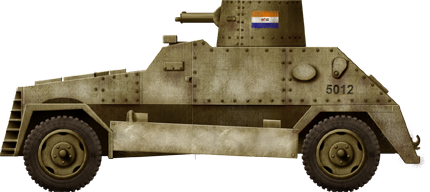
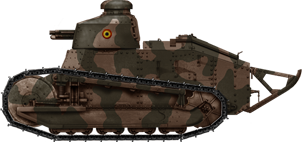
Belgian Renault FT. 75 were still held in reserve in early 1939, and replacements were on their way in the form of the ACG-1 medium tanks. This illustration is based on the Brussels army model on display at the Royal Museum of the Armed Forces in Brussels.
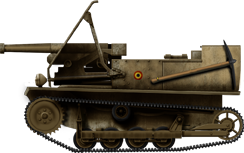
SA FRC 47 mm (1.45 in) mounted on a Carden-Loyd Mk.VI tankette. This early experiment was unsuccessful, as the hull was too light to cope with the muzzle blast and recoil of the gun. Only six were so converted. They were passed, in 1938, from the Chasseurs Ardennais to the Cycliste Frontiere regiment, and placed in fixed ambushing positions between Vivegnis and Lixhe (Meuse river western banks), firing some rounds on the Germans on 10-11 May 1940.
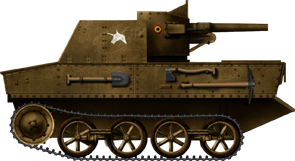
Vickers T13 Type 1, first version of this prolific tank-hunter (32 units delivered). The gun was partially protected, and could be fully traversed only when the driver compartment armored panels were folded. Unknown unit (unicorn), Cyclist Frontiere unit, central plains near Liege, May 1940.